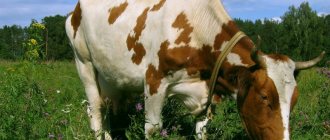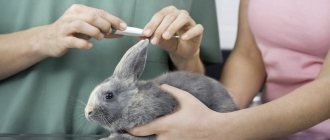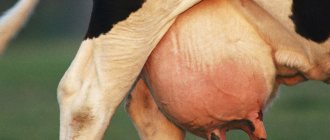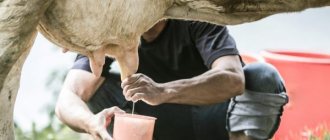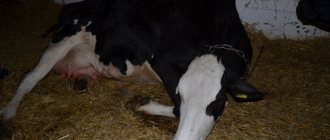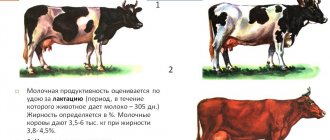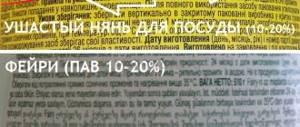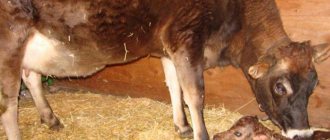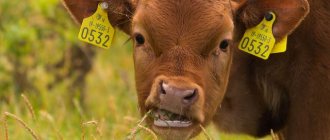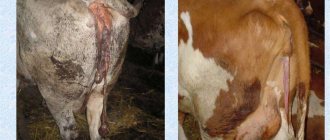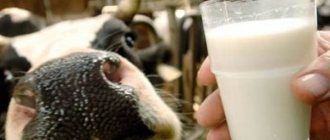Livestock » Cows and bulls
0
5665
Article rating
Kira Stoletova
Cows often develop warts, also known as papillomas. Once they appear on the nipples, they can significantly complicate milking, or even turn this process into an impossible action, so many people wonder how to treat warts on a cow’s udder. First, you need to form a clear concept of what exactly these formations are, and only after that can you begin treatment measures.
Warts on a cow's udder
Before starting treatment, you need to determine exactly what disease has affected the animal. Only by knowing the enemy in person can you select methods and means of treatment.
What are the causes of warts?
As in the case of human diseases, in animals it is also necessary to first determine the routes of infection, so that the treatment gives its results and the animals do not become re-infected.
Papillomas (the scientific name for warts) most often appear on the udder of cows under 2 years of age. This neoplasm mainly appears due to improper care or due to infection from a previously infected animal. Microcracks in the skin can also facilitate transmission of the virus from an adult to a calf. In addition, the likelihood of the disease affecting an animal increases rapidly when cows use vegetated swamps as a watering hole.
Methods of transmission of the papilloma virus
It is important to understand and realize that warts on a cow’s udder, even the smallest ones, are a sign that a disease of viral origin is progressing in the animal’s body. The virus, which is the causative agent of the disease, enters the animal’s body through wounds, abrasions, and also through cracks. Inventory items, such as:
- Buckets.
- Feeders.
- Drinking bowls.
Facts have been found indicating that the pathogen that causes formations on the cow's udder can enter the body through marks left on the skin or the use of medical equipment that has not been properly disinfected.
Warts that appear on a cow's udder can vary in size, ranging from very small to quite large. Their location can also vary in the same way. Papillomas in a cow can be located either singly or forming groups. In most cases, their distinctive feature is their shape - it resembles a mushroom and has a wide base, or it takes the form of a bunch, the base of which is a thin stalk. In rare cases, formations may merge with each other, resulting in the formation of folds. Also quite rare is the appearance of delaminations and cracks.
Why does the papilloma virus affect the udder area?
Papillomas occur anywhere in the animal’s body, but they are visible only on the udder, due to the lack of hair on this part of the cow’s body. It is for this reason that the opinion arose that warts only affect the mammary glands and nipples of cows.
Papillomas on the udder of a dairy cow can cause the main inconvenience - there is a decrease in the level of milk production and the appearance of painful sensations in the animal during milking, which cause corresponding reactions. It is very simple to prevent the disease; it will be enough to wash the udder several times a day with warm water and pay attention to the animal while walking.
Why does the papilloma virus affect the udder area?
The opinion that papillomas affect only the udder of a cow is erroneous.
They can spread throughout the body, affecting any part of the body or head. However, it is on the udder, which is not covered with hair, that warts are visible first. In addition, they are quickly noticed during milking, since it is the mammary glands that are subject to inspection, massage, and human touch. Other parts of the body are not amenable to such manipulations, which is why warts are rarely found on them. Warts on the udder, most often found in young heifers, are benign formations located on the animal’s nipples and significantly complicate milking or make it completely impossible due to severe pain for the animal. Such mushroom-shaped growths, sitting on a long thin stalk or wide base, can protrude above the surface of the skin or hide between the nipples.
Papillomas form on the surface of the entire body (from head to toe), but since they are simply not visible under the coat, but on the udder they are visible, there is an opinion that papillomatosis affects only the mammary gland and nipples. Warts cause the greatest discomfort during milking, which can be judged by the cow’s painful reaction and a significant decrease in milk production.
How are warts treated?
In some cases, it happens that warts may go away on their own, and then no treatment is required. It can also happen after the cow's first calving. This is due to the fact that animal immunity is strong enough, which has a corresponding effect on the self-healing process. A cow's immunity is strongest in the spring, when the feed contains a large amount of essential microelements and vitamins. However, this does not mean that warts will appear again due to re-infection of the animal.
One of the advice from veterinarians when it is necessary to treat papilloma on the udder of a cow is to vaccinate the sick individual. To do this, the removed wart is crushed, diluted with saline and glycerin, taken in equal quantities, up to 5%. Also, in order to destroy the activity of viral cells inside the resulting suspension, formalin is added. The final concentration should be 0.5%. Next, particles that have settled are removed from the resulting liquid, and the vaccine is administered in a dosage of 10 ml. Between injections you need to take a break of 2 weeks.
Is it necessary to treat papillomavirus in cows?
Some owners may argue that treatment of this disease need not be carried out if the warts do not interfere with the milking of cows. However, the opinion of veterinarians on this matter is diametrically opposite. Everything is due to the fact that the penetration of the virus into the animal’s body leads to a weakening of the immune system of the sick cow. As a result, it will be much more difficult to remove tumors in the future, so therapeutic measures should be taken if small papillomas have not disappeared. It is very important to have time to remove the virus from the body before calving, since virus cells can enter the calf’s body through contact with an infected cow, as mentioned earlier.
You can remove warts from a cow's udder using the simplest methods. One of these is ligation of formations. You need to take a hair from a cow's tail and tie the wart tightly at its base. This will cause it to dry out and soon fall off. But you should not lose sight of the fact that the proposed method is effective only in the case of single tumors.
Warts on the udder of a cow: what to do, how to treat them
Therapy is complicated by the resistance of the virus to unfavorable conditions. He is able to conduct normal life activities even at a temperature of 70 ° C for 30 minutes.
Dangerous microorganisms are not afraid of drying and thrive in glycerin. Cows at a young age are at risk, although adults do not have adequate protection against the disease.
Treatment of single growths
To combat papillomas on the nipples, hair wraps are used. This method has proven itself to be the most effective and easiest to implement.
Be sure to read:
Postpartum inflammation of the uterus, causes and treatment of endometritis in cows
The base of the wart is tied with a cow's tail hair at the very base. After some time, the formation dries out and is removed on its own.
There is a high probability of relapse, so the drug Kayod is used in parallel. The course of administration is designed for 1 month with daily use of 3 tablets.
After a thirty-day pause, therapy is resumed, and intramuscular injections of vitamins are added. This way you can relieve the symptoms of the disease, since most medications contain novocaine and other effective components.
Treatment of multiple warts
How to treat papillomatosis in cows? First of all, you need to stimulate the body's defenses. In such situations, warts on a cow’s udder disappear without treatment if the animal’s immunity is strengthened. This happens mainly at the end of spring, when the meager diet is enriched with green food, the barn becomes warm, dampness stops, and pollution decreases.
How to remove a growth without surgery? The simplest way to treat warts is to bandage the base of the papilloma if it narrows at the root.
When the blood flow is blocked, the tumor dries out and disappears after a short time. When warts interfere with the milking process, they are removed. If large defects are formed, stitches are applied. The wounds are treated with an aerosol - an antiseptic containing an antibiotic, for example, Ranozol or Terramycin spray.
If papillomas have formed on the udder of a group of cows, a comprehensive treatment is carried out, consisting of the following techniques:
- Optimizing your diet helps remove warts. The ruminant animal must receive a sufficient amount of bulky feed of good quality. Normalizing rumen digestion helps to increase immunity and destroy the virus that causes papillomatosis.
- Compliance with recommended zoohygienic parameters. The bedding should be fresh and the stall should be cleaned daily.
- Regular udder care. The organ must be kept clean. The market offers a wide range of nipple care products such as OxyCide Pre.
- Lubricating with special ointments after each milking helps get rid of growths. Levomikol, Anti-wart, Zinc ointment, Birch tar, Solidol are in demand. Flat-shaped polyps are treated with acetic or salicylic acid.
- It helps to fight warts by including Magnesium sulfate or Magnesium Oxide in the diet in an amount of 30...50 g per cow. The course of treatment is ten days.
- Intramuscular injections of Cyanocobalamin, 5 ml, every other day, with four treatments. First, 1.0 ml of novocaine 2% is injected under each wart.
- Immunomodulators - Mixoferon, Gamavit, Westin, Ligfol - will help cure a cow from growths on the udder, face, and other parts of the body.
Be sure to read:
The calf has no chewing cud: what to do?
Treatment of papillomas using folk remedies
Adherents of traditional veterinary medicine should keep in mind that the treatments recommended by experts for papillomas in cows require long-term, at least a month, and frequent use - up to 6 times a day. If a polyp interferes with milking, such treatment methods are unacceptable.
Drug treatments
Removing warts through surgery is an equally effective way to get rid of papillomas. In most cases, they are unscrewed or cut off, after which sutures are applied. It is very important not to leave a large wound at the removal site. In addition to suturing, to heal the wound and prevent infections, the site of wart removal is lubricated with aerosols that contain antibiotic substances.
With extensive papillomatosis in cows, treatment is carried out both externally and internally. Magnesia is used to eliminate infection internally. For 10 days, the animal is allowed to take 30 g of the product. As an external treatment, special products are used to lubricate tumors. As an ointment you can use:
- Lapis.
- A liquid nitrogen.
- Nitric acid.
- Salicylic acid.
- Acetic acid.
It is necessary to lubricate the warts daily, after the cow has been milked, until not a single new growth remains. It is necessary to ensure that the wounds do not become inflamed: this can lead to infection and fester.
Vitamin complex for treatment
Treatment of warts on a cow's udder can also be done with the help of vitamins.
Veterinarians use vitamin B12 as a medicine, which enters the body through intramuscular injections. Injections are carried out once every 2 days. The course of treatment is 4 injections. Before injecting vitamins, novocaine is usually administered using a 2% solution of the substance in an amount of 1 ml. This injection is performed under the base of the papilloma.
Another tip for implementing therapeutic measures for papillomatosis is the use of novocaine blockade. To implement this, it is necessary to inject Novocaine (1% solution) intravenously. The injection site is the animal's jugular vein. The duration of treatment is approximately 4 injections of the substance. Also, treatment of this disease can be carried out through the use of penicillin-novocaine. This substance is also injected into the vein of the cow, as well as around the tumors.
Prevention
treatment – 30 g. Therapy lasts a week. Locally, lapis pencil and solutions with salicylic, nitric and acetic acid are used as a supplement. Papillomas need to be wiped off every day after milking. Sessions are carried out until the growths go away. Be sure to ensure that inflammation and suppuration do not appear.
Vitamin B12 is also used as a supplement to remove tumors.
It is administered intramuscularly. The procedure is carried out once every couple of days. Only 4 injections are required. Before injection, a 2% solution of novocaine is usually used. Just 1 ml is enough. The injection is made under the base of the growth that needs to be removed.
Another option that will help get rid of papillomatosis is novocaine blockade. novocaine is injected intravenously (1 percent solution). The course involves 4 such injections. Also use
Treatment of papillomas using folk remedies
Papillomatosis can be cured not only with the use of medications and surgery. Over hundreds of years of breeding and keeping cows, people have come up with many remedies that help get rid of warts without the use of medications.
Onion and wax mixture
The most well-known folk remedy for treating cow warts is using onions. To prepare it, pour 1 tbsp into the pan. vegetable oil, fry an onion in it, the size of which is quite large. The onion should reach a golden color. After this, you need to remove the vegetable and leave the oil on low heat for another 5 minutes. Next, you need to add 25 g of wax to the oil and bring the mixture to a boil.
Next, you need to cool the resulting liquid and pour it into a jar. This product allows you to eliminate tumors within 12 days.
Curd whey
Another non-drug treatment used in the case of papillomatosis is cottage cheese serum. It is applied as follows. The liquid is poured into a large container and left in the open air. From time to time you can add more whey to the bowl.
The essence of the treatment is to regularly lubricate the udder of an infected cow. The duration of treatment with this method is 3-5 weeks.
Potato decoction
Potato decoction can also help cure cattle from this disease process. To prepare it, sprouted potatoes are used, but the shoots are not removed.
The decoction is applied to the udder of a sick animal until the papillomas are completely cured three times over 24 hours, then a break is taken for 2-3 days and treatment is resumed.
Garlic mixture
This disease can also be treated using the garlic method. Take garlic and lard in equal quantities and then mix. The resulting mixture is used for daily rubbing of the udder. At the same time, it is necessary to ensure that the wounds do not become inflamed, this will cause pain to the animal and disrupt the milking process.
Treatment
The main problem why, when a wart is detected in a cow, a mandatory course of treatment is the presence of discomfort that the animal itself feels during milking.
If the warts bother an individual particularly strongly, she will not allow herself to be milked. A long absence of milking negatively affects the overall health of the cow and can develop serious complications.
How to treat a cow and its udder? In this case, you can use two methods:
- Seek help from your doctor to obtain advice and prescribe the necessary medications for effective treatment.
- The use of traditional medicine, which have proven themselves to be effective recipes for the development of warts.
Some cow owners use a simple and accessible method - they bandage the area of the growth with a special thread or with simple hair from the animal’s tail. This method is only valid when the cow has only a single and fairly large growth that can be tied.
Other home treatments
Also in the arsenal of folk remedies for the treatment of warts on the udder there are the following methods:
- Lubricating the udder with grease.
- Rubbing diluted grated horseradish juice (diluted in a ratio of 1 to 1).
- Washing the udder with lungwort solution 6 times every 24 hours.
- Applying sour apple juice to virus-affected areas.
Solid oil does not irritate the skin, but it is difficult to wash off from the udder. Horseradish may cause a burning sensation in areas where the skin is damaged or where growths have been removed. Lungwort is not an effective remedy; veterinary medicine does not recommend it, considering that such a solution is poisonous to livestock.
How to treat papillomas?
Igor Nikolaev
auto RU
Often livestock owners are in no hurry to rid the animal of papillomas. Some people believe that the warts will dry out and fall off. However, possible damage and infection of tumors should cause livestock producers to consider treatment options. In addition, denser formations are much more difficult to get rid of.
More on the topic: Are vitamin and mineral supplements needed for cows?
To begin with, the cow is placed separately from its relatives, its diet, care, and living conditions are improved. After this, the veterinarian performs the following manipulations:
- cuts out warts;
- cauterizes tumors with high frequency currents, carbolic acid;
- a special thread is applied to the stalk of the papilloma to ligate the blood vessels;
- low temperatures are used;
- small growths are smeared with acetic acid.
When there are a lot of warts, the cow is given thirty grams of magnesium daily for ten days. At the same time, they are lubricated with salicylic ointment. They use special creams for warts, which are sold in veterinary pharmacies. They can be used for many days, including on the udder of a cow.
To get rid of tumors on the mammary glands, vitamin B12 is injected intramuscularly. Novocaine along with penicillin is injected into the root of the wart. For the first drug two days are enough, for the second four.
Sometimes livestock breeders trust traditional methods.
- grated onion gruel is applied to papillomas;
- lotions are made from garlic infusion, which is brewed with boiling water;
- wipe the warts with sour apple juice;
- washing tumors with potato decoction several times a day;
- wet warts are wiped with ammonia;
- They use the juice of celandine, dandelion and other herbs.
Conspiracy for the treatment of papillomas on the udder
Trying to find a solution to a problem, some people use non-standard methods and act in the most unusual ways. For cow papillomatosis, there is also an extraordinary method of treatment: a spell for warts that appear on the udder.
The simplest but most effective method of such therapy is the following ritual. Take a cotton thread or rope, tie exactly 40 knots on it, while reading the Lord’s Prayer. Then bury the item you are using in the ground. The papillomas will fall off on their own as soon as the rope or thread rots.
Prevention of udder disease
- The milking area must be clean and dry.
- Milkers should have their hands washed with soap and dried with a towel.
- Wash the animals' udders with clean, warm water and wipe dry.
- Strict adherence to all rules of mechanical milking.
- Be attentive to the condition of the cow's udder, beware of wounds, abrasions, burns, and cracks.
- Separate keeping of animals infected with the virus. If an animal has mastitis, immediately separate it from the herd and milk it in a separate container.
Important! The process of treating a sick animal must be carried out patiently, carefully and conscientiously, otherwise a relapse will occur.
The appearance of a bruise, swelling or wart on the udder of an animal should alert its owner; the earlier the disease is diagnosed, the easier and faster the cure. Be attentive and caring to your breadwinners.
